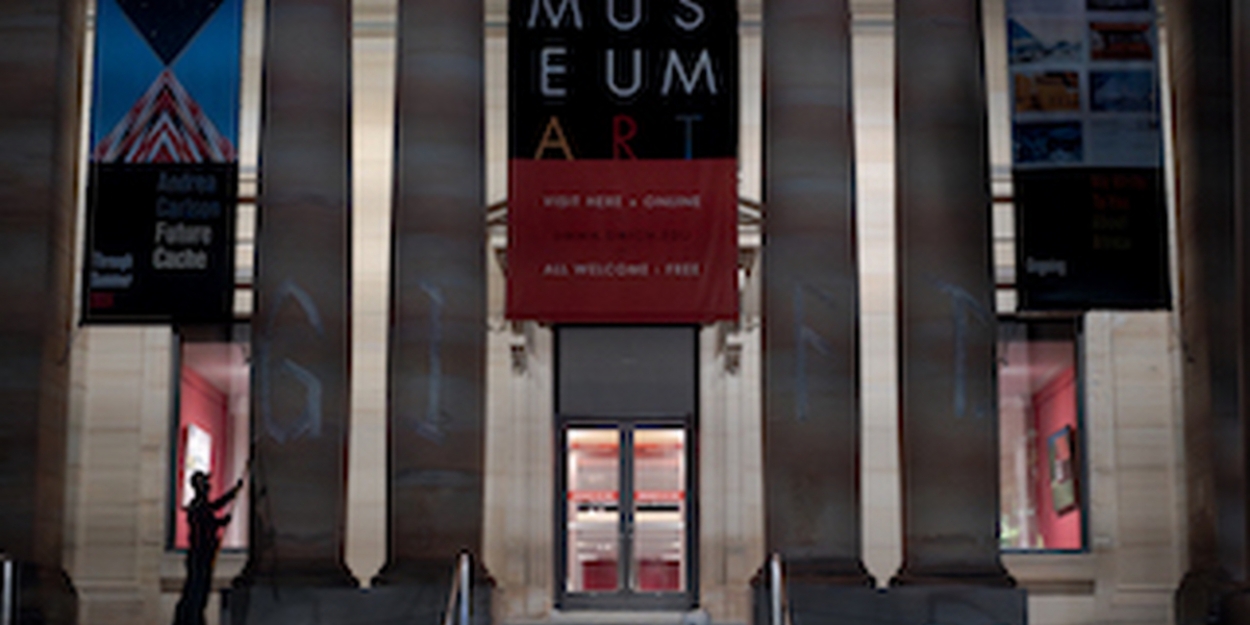Cannupa Hanska Luger 'GIFTS' University of Michigan Campus with Public Art Installation
Part of ongoing campuswide initiative to challenge university history, reexamine what gets memorialized.

The University of Michigan Museum of Art has a new face.
Across the facade of Alumni Memorial Hall—a neoclassical building that opened in 1910 to commemorate U-M students and staff who served in the Mexican-American, Civil, and Spanish-American wars, and home to UMMA—is the experimental installation, "GIFT," commissioned by artist Cannupa Hanska Luger.
"GIFT" is a reference to the 1817 Treaty of Fort Meigs, which states that Ottawa, Chippewa and Potawatomi tribes gifted land to the University of Michigan, upon which the Ann Arbor campus was built.
To explore the meaning of gifting within both the contexts of colonialism and Indigenous communities, Luger painted the word "GIFT" in white porcelain clay slip on the columns of the building. In the days following, Luger and a team of collaborators will continue to paint around the letters, covering the entire historic facade with a layer of white clay and eventually covering the letters themselves.
Born on the Standing Rock Reservation in North Dakota, Luger is an enrolled member of the Three Affiliated Tribes of Fort Berthold. According to a statement from his website, Luger creates "monumental installations, sculpture and performance to communicate urgent stories about 21st Century Indigeneity (by combining) critical cultural analysis with dedication and respect for the diverse materials, environments and communities he engages, while provoking diverse audiences to engage with Indigenous peoples and values apart from the lens of colonial social structuring,"
Luger said the stone of Alumni Memorial Hall is sandstone from Ohio that was quarried and extracted, and rebuilt into a Greek and Romanesque story in Michigan.
"The architecture itself embeds a history into the campus that was never here," he said. "It is a monument to civilization and thought and enlightenment; but it is also an imposition and an extraction from the very land that we're standing on. With 'GIFT,' I want to do the same thing, present an imposition drawn from an extraction.
"Using Kaolin, a white clay from North America, I'm going to resurface the exterior of the Museum, presenting it as white as I think it is. And then in cooperation and relationship with the environment, the weather will remove that thin exterior and re-expose the indigenous stone of the land."
Through this commission, UMMA opens the door for the campus community to consider the monuments they have inherited and imagine what possible new structures are needed to commemorate histories that have been invisible or underrepresented.
This is a key example of programming around the U-M theme semester, Arts & Resistance—a cross-campus partnership between UMMA, U-M Arts Initiative and the College of Literature, Science, and the Arts—which reflects on how creativity and making can arise out of oppression and destruction.
With "GIFT," Luger activates weather and time as co-conspirators, challenging perceptions of permanence in memory, history and even physical structures. The installation embraces the meaning of "gifting" within Indigenous communities, where it signifies the giver's success, abundance and ability to offer something of value.
In this way, "GIFT" prompts critical thinking about cultural perspectives and encourages more nuanced thinking about historic storytelling and mythmaking.
UMMA is also implicated in this essential process, as museums stand as stewards of cultural history and heritage. The use of the white clay slip and its slow dissolution signifies an invitation to dismantle the existing white-centric structures that guide many museum practices.
"GIFT" is but one part of "Cannupa Hanska Luger: You're Welcome," Luger's three-part project that examines the history of the land on which U-M sits and its relationship to broader dialogues about land sovereignty, colonialism, memorialization and the cultural perspectives of and implications for Indigenous communities.
The in-gallery exhibition of "You're Welcome" creates a dynamic interplay between several of the artist's sculptural installations and works selected from UMMA's expansive collection.
The project also includes the Monument Lab: Public Classroom, which offers a space for dialogue and further contemplation of key themes within "You're Welcome," especially the central curatorial question: "How do we remember on this campus?"
"As we work together with our communities on creating relevant and meaningful artistic experiences, we necessarily need to examine how museums both produce and disseminate shared cultural history—both as it was once told and also as it is being retold today," said UMMA Director Christina Olsen. "Our collaboration with Cannupa Hanska Luger allows us to reshape the narrative of a building central to our museum and to our campus to reflect a broader, more nuanced and more accurate history that embraces different perspectives and lifts up diverse cultural experiences."
"GIFT" was commissioned by UMMA with support from the U-M Arts Initiative. "Cannupa Hanska Luger: You're Welcome" is curated by Ozi Uduma, UMMA's assistant curator of global contemporary art, and Paul Farber, director and co-founder of Monument Lab and curator-in-residence for the Arts Initiative. It will remain on view through Feb.18, 2024, and is free and open to the public.
Comments

Videos

